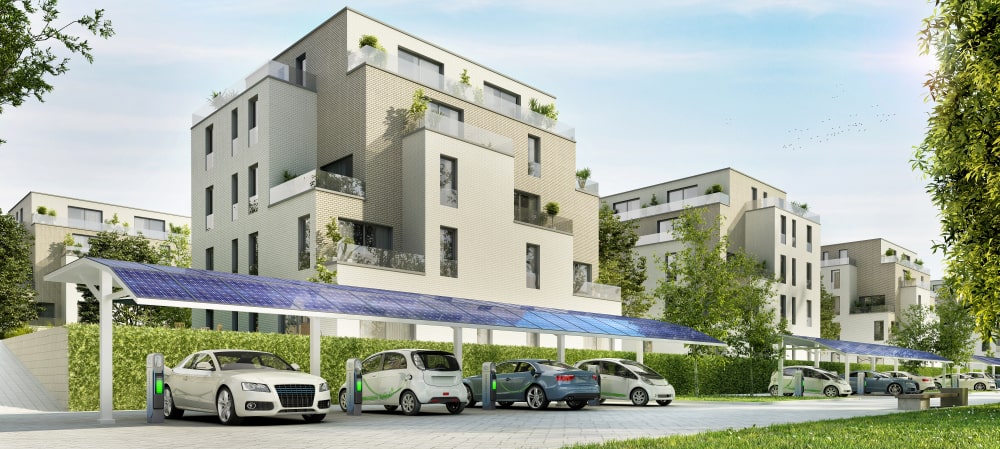Sector - Energy, Fuel & Utilities
Building homes that are fit for the future

With floods sweeping eastern England, the UK experiencing some of its highest recorded temperatures in history and temperatures in France reaching an all-time high of 45.6 degrees Celsius all within the last few months, humans’ impact on climate change is very much at the top of the national and international agenda. Earlier this year, energy-inefficient homes were identified as damaging efforts to tackle climate change. With the goal of making Britain carbon neutral by 2050, the ‘Future Homes Standard’, due in 2025, is set to enforce minimum environmental standards for all new housing.
At the time of the report’s publication in February 2019, reductions in emissions from the UK’s 29 million homes appeared to have stalled, while energy use in homes – which accounts for 14% of total UK emissions – had increased between 2016 and 2017.
In already unstable political and economic times, these changes are set to have a marked impact on the construction industry’s future approach, so how can the industry ensure that the next generation of UK housing ticks all the environmental boxes?
Across the country, housebuilders and developers are currently grappling with the need to increase the number of homes available, while ensuring that quality remains high. The introduction of the Future Homes Standard, which emphasises the need for alternative energy installations and the use of low-carbon materials, only drives the need for organisations to continue striving for better standards across the board.
With this in mind, the industry has reached a critical point where housebuilders must decide between providing less sustainable dwellings, or good quality homes that can be adapted to suit the needs of an increasingly diverse population. This should be an easy decision; after all, the principles set out in the new standards reflect best practice. Yet, historically, budget constraints have been an issue, resulting in homes falling short of necessary standards and more money having to be spent retrofitting these short-term housing solutions for long-term use.
The Future Homes Standard presents several key challenges for the construction industry and housebuilders, principally, the need for homes that reflect the needs of a varied market. Unlike the UK’s European counterparts, who have diversified their housing stock to suit the changing requirements of the population, homes in the UK are still mostly built to suit the average 2.2-person family and leave little room for more modern family structures or living arrangements.
Times have changed and the modern-day market now requires far greater flexibility than ever before. Recent reports have highlighted the need for safe and comfortable homes for the elderly, while students and young professionals search for flexible, modern spaces that suit their immediate needs.
The Future Homes Standard offers developers and housebuilders the exciting opportunity to redefine the housing market, providing a greater spread of properties that are designed with adaptability in mind. Should the sector bring these factors together, there is huge opportunity for change.
The UK housing market is notoriously slow to adapt; therefore, these standards require a huge leap of faith from most developers, particularly for the ‘big players’ in the sector. From the supply and use of new materials – all of which will require rigorous health and safety testing – to the development of new skillsets, the changes are likely to present several initial challenges.
Yet, certain areas of the market which are being driven by increasing demand, such as the private rental sector and later living market, also present significant opportunities to embrace innovation and take a new approach to housing. This is true both in terms of the design standard and build specification.
This increase in quality will likely be reflected in the price of the homes on offer; some schemes with exceedingly tight margins, which are only just viable at the moment, may become increasingly difficult to deliver, and sell, under the new standards.
Consequently, the UK government must provide a solution that is more carrot than stick, starting with a material reduction of Stamp Duty on homes that meet the new standards. With a less-than-exemplary track record when it comes to the support of alternative energy sources, the Government must deliver consistent, balanced messages and engage in giving back in economic terms. While many in the industry may wish to change their approach to sustainable building, they are unlikely to do so very quickly.
Previously, some contractors may have perhaps shied away from building to the highest possible standards due to the costs incurred. However, the solutions proposed by the new standards and the Government must no longer just be aspirational, they must be deliverable. Critical factors such as supply chain, recognising the necessary skill sets and the costs involved must all be well considered.
Merely producing the standards and walking away will not work this time. Instead, the standards must be developed in conjunction with innovative thinking, financial incentives, and industry-wide consultation.
To ensure that UK housing is fit for the future, it mustn’t be forgotten where the industry was in the past, and what it needs to do to move forward – the days of cutting corners are long gone. The Government and housebuilders must now work together to embrace change and share the costs involved, where possible. If done well, the Future Homes Standard offers an opportunity to completely reimagine housing, from the ground up.
Article submitted by Martin Jones, partner and head of the projects and infrastructure group at law firm, Shakespeare Martineau.
Related Articles
More Energy, Fuel & Utilities News
- Belfast Harbour Secured as £100 Million Hub for Major Offshore Wind Projects
10 Dec 25
Belfast Harbour is set to become the primary assembly and construction hub for two of
- Wylfa chosen as SMR site
2 Dec 25
Great British Energy has confirmed that Wylfa on Anglesey has been selected as the site
- £10M for EV charging tech
27 Nov 25
New cutting-edge technology, backed by £10 million of government funding will allow electric vehicle (EV)






